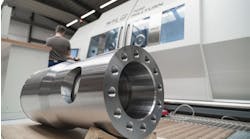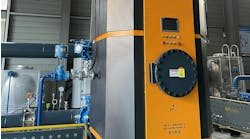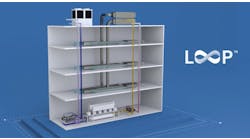The new version of Simufact.forming provides optional access to several direct CAD interfaces (Pro/Engineer, CATIA v4/v5, UniGraphics, Parasolid, Inventor and SolidWorks), and it supports general data formats (IGES, STEP, VDA-FS or ACIS), so geometrical data import is easier and the connection to existing CAD tools is improved.
Simufact Engineering GmbH, a provider of software and services for bulk metal forming, announced in July the release of version 8.1 of Simufact. forming, an advanced integrated software solution for bulk metal forming. According to the company, the new developments focus on providing a good implementation of the software into the user’s working environment. Also, the software is said to be user friendly, easy to learn, and displays many features for practical application.
The program uses the two solution methods: the Finite Element Method and the Finite Volume Method. The software is based on the merger of two separate, long-established programs, MSC.SuperForm and MSC. SuperForge, which were developed by MSC.Software. At the end of 2006, MSC.Software decided it would be in the best interest of end-users for the company to divest MSC.SuperForge and MSC.SuperForm. When they became available, Simufact Engineering quickly arranged to acquire them.
Early involvement
As chief technology architect for Simufact Engineering (www.simufact.com), Dr. Hendrik Schafstall spent the past 13 years preparing to launch Simufact.forming. In the 1990s, as he conducted doctoral research on “Fr iction Modeling in Bulk Metal Forming Simulation,” Schafstall realized the power of the finite-element method. In 1995, together with Michael Wohlmuth, he established a company dedicated to simulating manufacturing processes. Since then, they have worked with an array of customers, small and large, who have benefited from their expertise and the unique technologies offered. Today, Schafstall and Wohlmuth serve as co-managing directors of Simufact Engineering.
Typical examples of simulations using the finite-element approach are hot and cold forging, tool and die stress analysis, and rolling and reducing.
One benefit from these simulations is the early detection of flaws in the process, like die under-fill and creation of cracks, folds, and laps. It also allows evaluation of the die-loads and the stresses that are developed inside the dies, and determination of the residual stresses in the part after forming.
Simufact.forming 8.1 makes it possible to check and clean geometrical data automatically, and to simplify tool geometry for tool analysis.
An important feature of Simufact. forming is not only that it accounts for the plasticity of the material behavior, but it also incorporates information on the elastic deformations and corresponding stresses. This provides an accurate calculation of the pressure that is applied to the tools, and it also provides an accurate calculation of the residual stresses in the final part after removal from the press.
This insight allows optimization of material usage, avoids expensive trial- and-error runs on the production line, makes it possible to significantly increase tool life, and allows the designer/ developer to make estimates about the service life of the part — which helps to lower the warranty costs that result from early failures.
Early on, Schafstall recognized the complementary nature of this approach with the finite-volume method, which MSC.Software first applied to the simulation of forging processes in 1999. As a partner to that company, he had early access to the technology, and immediately started applying it to 3-D hot forging processes that until then had been “unsolvable,” or took so long to solve that they were impractical.
Simufact claims that the finite-volume method of Simufact.forming will be the most accurate and cost-effective solution method available for solving complex 3D material flow. On a desktop or laptop computer with a dual- or quad-core CPU, most simulations can be run within an hour of simulation time. Only the most complex cases require more time, and for those extreme cases, it is possible to run the simulation on a dedicated Linux server.
Program development
Following are some key improvements that have been made with Simufact. forming 8.1:
- The tool contains improved meshing technology, which is proven to be more efficient, robust, and powerful than past versions.
- Simulation times have been reduced.
- The introduction of parallel computing allows larger models to be calculated faster which, in turn, provides quick results.
- The already existing interfaces to external CAD/CAE tools have been expanded to include direct interfaces to all standard and many third-party products.
“As the manufacturing landscape becomes more and more competitive, many companies are looking for ways to improve their processes and increase their product portfolio to offset the price pressure on existing parts in production. The much anticipated release of Simufact.forming 8.1 will greatly assist with these goals, as simulation is becoming a necessary and critical part of every companies design process,” says Wohlmuth.
“Our software for bulk metal forming has an over-all improved performance and is more efficient and robust. The standard user in bulk metal forming will be able to quickly adopt the new software environment. I see many advantages for the user, especially as the software is based on the new solver technology of MSC.Marc and MSC.Dytran.”
According to Dr. Schafstall, “The industry is transitioning to Windows 64 bit, running on dual-core and quadcore CPUs. This environment is supported by Simufact.forming 8.1, allowing efficient simulation of very large and detailed models. By introducing smaller details in the analysis, more aspects of the material flow can be studied and optimized, leading to significant cost savings during the physical try-out phase.”
Improved CAD integration, better meshing technology
With the new version, users have optional access to many direct CAD interfaces, such as Pro/Engineer, CATIA v4/v5, UniGraphics, Parasolid, Inventor, and SolidWorks. The software also supports general data formats such as IGES, STEP, VDA-FS, or ACIS. Thanks to this support feature, geometrical data import is now easier and the connection to existing CAD tools is also improved.
Additionally, Simufact.forming 8.1 offers the possibility to automatically check and clean geometrical data and the new functionality to automatically simplify tool geometry is useful (i.e. for the closing of drilling holes) for data preparation in efficient tool analysis.
The new software version contains Simlab’s advanced meshing technology, which helps mesh components faster and with a higher level of quality than previous solutions. The new meshing technology also supports automated punching and deburring.
Flow lines, friction calculation, tool forces, and wear analysis
With the new version of the software the user is able to easily define many different flow lines, in two and three-dimensional models. Examples for this feature are the shear trap or middle line tracing and the fibre flow visualisation. Version 8.1 also offers new features for friction modelling. The combination of Coulomb friction and the maximal shear stress model allow for an even more realistic illustration of grain structure.
The range of functions in Simufact. forming 8.1 now include new capabilities for calculating tool forces and tool stresses for developing optimal tool design.










